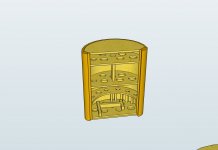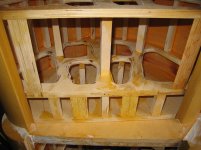Secondly you want nonparallel surfaces and unequal distances to help avoid standing waves from developing.
John
John
This is simply not true. It can be proven that any fixed volume, despite its shape (reasoanably low aspect ratios assumed) will have the same modal density and the same frequency of its first resonance. The modes shapes will differ in every case, but the number of modes in any fixed frequency interval is virtually independent of shape. This is not true of panels, of course, but it is true of the acoustic interior - they are entirely different problems.
John
This is simply not true. It can be proven that any fixed volume, despite its shape (reasoanably low aspect ratios assumed) will have the same modal density and the same frequency of its first resonance. The modes shapes will differ in every case, but the number of modes in any fixed frequency interval is virtually independent of shape. This is not true of panels, of course, but it is true of the acoustic interior - they are entirely different problems.
..but you can *add* non-parallel surfaces (adjusting for added displacement) with the same volume.
Same box modes?
So, a floor standing cabinet with internal measurements 12" x 12" x 48" will have the same internal box modes as a 19" cube?John
This is simply not true. It can be proven that any fixed volume, despite its shape (reasoanably low aspect ratios assumed) will have the same modal density and the same frequency of its first resonance. The modes shapes will differ in every case, but the number of modes in any fixed frequency interval is virtually independent of shape. This is not true of panels, of course, but it is true of the acoustic interior - they are entirely different problems.
So, a floor standing cabinet with internal measurements 12" x 12" x 48" will have the same internal box modes as a 19" cube?
..The modes shapes will differ in every case..
So, a floor standing cabinet with internal measurements 12" x 12" x 48" will have the same internal box modes as a 19" cube?
Thats a very large change in aspect ratio so it deviates at the very lowest frequency, but as the frequency goes up the "modal density" of the two becomes the same, yes. If you reread my claim, I said that the aspect ratio needed to stay approximately the same. For example; take your cube and tilt every wall 20 degerss of so, there will be no change in the frequency of the lowest mode. Start stretching it and yes, the lowest mode lowers, but the density stays constant.
Tilt
I see what you are getting at now. Making the walls non-parallel or adding internal diffusion will change the distribution and amplitude of the internal modes very little?Thats a very large change in aspect ratio so it deviates at the very lowest frequency, but as the frequency goes up the "modal density" of the two becomes the same, yes. If you reread my claim, I said that the aspect ratio needed to stay approximately the same. For example; take your cube and tilt every wall 20 degerss of so, there will be no change in the frequency of the lowest mode. Start stretching it and yes, the lowest mode lowers, but the density stays constant.
Thanks guys for correcting me.
Yes I was wrong – well – partly wrong – or in other words : not completely right

*But* you are not completely right either.

Where I made a mistake is that „consecutively min phase *in general* can not be corrected“, well I agree it *can* be corrected – if possibly not in any case.
But as thats after a common agreement on „consecutively min phase“ as such taking place – I leave that for the moment (guess it will be a lot of fun to discuss correct-ability by its own).
To get a better handle on the concept of „consecutively min phase“ I've set up some basic simus to give a picture.
It simulates the behaviour of two point sources placed at 1ms delay time distance to make it easy to grasp the effect in a qualitatively manner at first hand.
The traces shown are :
the original signal in RED
the overlay of the two point sources WITHOUT any low pass filtering of the second part of the doublet in BROWN
the overlay of the two point sources WITH an (arbitrary) low pass filter for the second part of the doublet in BLUE
To put things into perspective, different sine bursts are shown at peaks and nulls and also at frequencies well below „first baffle peak“
Assumed here is an ideal speaker in the sense that there is no LP or HP for the point source in front
2000 Hz :

1500 Hz :

1000 Hz :

750 Hz :

500 Hz :

250 Hz :

125 Hz :

75 Hz :

25 Hz :

The BROWN trace is the trace of an „idealized“ OB dipole showing perfect nulls and peaks – or any other speaker with discrete time delay (and equally applies to room effects) as mentioned above.
We see the point of „changing gear“ is at 1ms – befor that we only hear the first half of the doublet (monopole presentation), after that, the second half of the doublet is overlayed and we actually listen to dipole.
In the simplified simu at hand, the two consecutively min phase parts are sharply seperated from each other.
So, at 1ms there is a considerable kink in the „SPL pressure“
With frequencies going up the low pass filter (taking somehow care of frequency dependent diffraction / beaming effects affecting the second part of the doublet) becomes more and more effective, what leads to a flattenig of the peaks and nulls that would happen otherwise.
Now – that we know what to watch out, real world measurements would be fine for confirmation.
The challenge here is, that usually the two min phase parts are not as sharply separated as in the simu – so, looking for a sharp and distinct kink would probably be not the best idea – anyway I guess the effect is real and even if not happening in the pronounced way shown by the simus, further investigation seems interesting.

Michael
Yes I was wrong – well – partly wrong – or in other words : not completely right
*But* you are not completely right either.
Where I made a mistake is that „consecutively min phase *in general* can not be corrected“, well I agree it *can* be corrected – if possibly not in any case.
But as thats after a common agreement on „consecutively min phase“ as such taking place – I leave that for the moment (guess it will be a lot of fun to discuss correct-ability by its own).
To get a better handle on the concept of „consecutively min phase“ I've set up some basic simus to give a picture.
It simulates the behaviour of two point sources placed at 1ms delay time distance to make it easy to grasp the effect in a qualitatively manner at first hand.
The traces shown are :
the original signal in RED
the overlay of the two point sources WITHOUT any low pass filtering of the second part of the doublet in BROWN
the overlay of the two point sources WITH an (arbitrary) low pass filter for the second part of the doublet in BLUE
To put things into perspective, different sine bursts are shown at peaks and nulls and also at frequencies well below „first baffle peak“
Assumed here is an ideal speaker in the sense that there is no LP or HP for the point source in front
2000 Hz :

1500 Hz :

1000 Hz :

750 Hz :

500 Hz :

250 Hz :

125 Hz :

75 Hz :

25 Hz :

The BROWN trace is the trace of an „idealized“ OB dipole showing perfect nulls and peaks – or any other speaker with discrete time delay (and equally applies to room effects) as mentioned above.
We see the point of „changing gear“ is at 1ms – befor that we only hear the first half of the doublet (monopole presentation), after that, the second half of the doublet is overlayed and we actually listen to dipole.
In the simplified simu at hand, the two consecutively min phase parts are sharply seperated from each other.
So, at 1ms there is a considerable kink in the „SPL pressure“
With frequencies going up the low pass filter (taking somehow care of frequency dependent diffraction / beaming effects affecting the second part of the doublet) becomes more and more effective, what leads to a flattenig of the peaks and nulls that would happen otherwise.
Now – that we know what to watch out, real world measurements would be fine for confirmation.
The challenge here is, that usually the two min phase parts are not as sharply separated as in the simu – so, looking for a sharp and distinct kink would probably be not the best idea – anyway I guess the effect is real and even if not happening in the pronounced way shown by the simus, further investigation seems interesting.
Michael
Last edited:
...
One can conceptualize whatever one wants to try to present it, this changes nothing. There actually is no "doublet" or second impulse in reality, since diffraction of any baffle and more especially with any real non-point source driver is a distributed issue. The concept of "consecutively min phase behaviour" of which you speak might be a better way to describe it as it is the integrated response from the diffracting points.
...
Dave
As much as I agree that the effect of „consecutively min phase“behaviour will often be masked, I nevertheless find it worth the effort to bring down the discussion to a point where common ground could possibly be achieved
This is out of two reasons
1.) the consequence of the concept of CMPB is a pretty unique form of distortion that isn't exactly easy to deal with and I doubt many are aware of its shere existence (hence Lynn is referencing to the "multi path" issue in the HF department - simply no naming or consciousness here in audio)
2.) I haven't seen this specific form of distortion to be characterized and outlined elsewhere ( thouigh I possibly could have overlooked it easily )
And again - I'm not discussion 3-D here nor does John nor Jean-Michel - though the issue of course is highly 3-D connected.
The core issue *for the listener* though lyes in the time domain as I tried to make clear with my simus above.
My posts are in continuation to the same - pretty long - discussion about that subject, that started out way back in this thread - spread to other threads - and comes back here again.
Michael
Last edited:
Here's the current Sketchup model for the bass cabinets. It's missing much of the bracing but gets the idea across. This isn't vaporware btw, just sketchup makes a more understandable look than my current pics. There are "ribs" like shown all the way around. 31" height.
Attachments
nice looking. It reminds me of a few things...but it's a much more affordable implementation than most of those.
Why not have a brace that goes all the way through the enclosure to connect the top and bottom plates?
There are ribs between each of the shelf braces, but no, there's not a full top-bottom continuous brace. The bottom has many braces distributed over the surface of it, and connected to the first shelf brace, which has more connections to the second.
Attachments
Construction of my cabinets was completed today. One more weekend of opera performances, then next week I can prep them and apply the DuraTex.
Further work on the speaker project will have to get in line, though. Next Monday I get to pick up my new Kawasaki Versys!
Gary Dahl
Further work on the speaker project will have to get in line, though. Next Monday I get to pick up my new Kawasaki Versys!
Gary Dahl
Attachments
BudP,
What happened to your newly designed speakers? I recalled you posted a schematic somewhere within this relatively short thread.
I assume the bike is for Solveig?
Boy, does she wish!! But she's only 13 so the most she could hope for would be riding two-up with me. But Solveig had better not hold her breath...Tineke won't even let me get her a helmet.
Gary
Last edited:
BudP,
What happened to your newly designed speakers? I recalled you posted a schematic somewhere within this relatively short thread.
Not sure what you are referring to. For a short time I was using the Azurahorns AH-425's with the GPA-288's on top of the Klipsch Chorus II's, using their woofer sections only, but the Klipsch woofer wasn't smooth enough through the crossover and it didn't seem worth the effort. A few years ago I bought a set of Von Schweikert VR4's and got them upgraded at the factory. I sold them earlier this year and am now listening to AN-E's. The Ariels are in storage. I don't think the woofer surrounds are very compliant anymore, but I'd like to listen to them again sometime.
Gary
- Home
- Loudspeakers
- Multi-Way
- Beyond the Ariel


